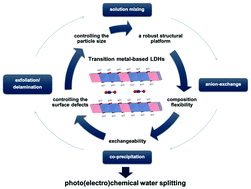Transition metal-based layered double hydroxides for photo(electro)chemical water splitting: a mini review
Abstract
The conversion of solar energy into usable chemical fuels, such as hydrogen gas, via photo(electro)chemical water splitting is a promising approach for creating a carbon neutral energy ecosystem. The deployment of this technology industrially and at scale requires photoelectrodes that are highly active, cost-effective, and stable. To create these new photoelectrodes, transition metal-based electrocatalysts have been proposed as potential cocatalysts for improving the performance of water splitting catalysts. Layered double hydroxides (LDHs) are a class of clays with brucite like layers and intercalated anions. Transition metal-based LDHs are increasingly popular in the field of photo(electro)chemical water splitting due to their unique physicochemical properties. This article aims to review recent advances in transition metal-based LDHs for photo(electro)chemical water splitting. This article provides a brief overview of the research in a format approachable for the general scientific audience. Specifically, this review examines the following areas: (i) routes for synthesis of transition metal-based LDHs, (ii) recent developments in transition metal-based LDHs for photo(electro)chemical water splitting, and (iii) an overview of the structure–property relationships therein.

- This article is part of the themed collections: Nanoscale Horizons, Nanoscale, and ChemComm: Nanocatalysis and Recent Review Articles


 Please wait while we load your content...
Please wait while we load your content...